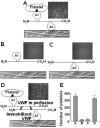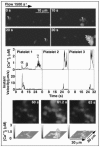Platelet adhesion under flow
- PMID: 19191170
- PMCID: PMC3057446
- DOI: 10.1080/10739680802651477
Platelet adhesion under flow
Abstract
Platelet-adhesive mechanisms play a well-defined role in hemostasis and thrombosis, but evidence continues to emerge for a relevant contribution to other pathophysiological processes, including inflammation, immune-mediated responses to microbial and viral pathogens, and cancer metastasis. Hemostasis and thrombosis are related aspects of the response to vascular injury, but the former protects from bleeding after trauma, while the latter is a disease mechanism. In either situation, adhesive interactions mediated by specific membrane receptors support the initial attachment of single platelets to cellular and extracellular matrix constituents of the vessel wall and tissues. In the subsequent steps of thrombus growth and stabilization, adhesive interactions mediate platelet-to-platelet cohesion (i.e., aggregation) and anchoring to the fibrin clot. A key functional aspect of platelets is their ability to circulate in a quiescent state surveying the integrity of the inner vascular surface, coupled to a prompt reaction wherever alterations are detected. In many respects, therefore, platelet adhesion to vascular wall structures, to one another, or to other blood cells are facets of the same fundamental biological process. The adaptation of platelet-adhesive functions to the effects of blood flow is the main focus of this review.
Figures






References
-
- Schulze H, Shivdasani RA. Mechanisms of thrombopoiesis. J Thromb Haemost. 2005;3:1717–1724. - PubMed
-
- Junt T, Schulze H, Chen Z, Massberg S, Goerge T, Krueger A, Wagner DD, Graf T, Italiano JE, Jr., Shivdasani RA, von Andrian UH. Dynamic visualization of thrombopoiesis within bone marrow. Science. 2007;317:1767–1770. - PubMed
-
- Weyrich AS, Lindemann S, Tolley ND, Kraiss LW, Dixon DA, Mahoney TM, Prescott SP, McIntyre TM, Zimmerman GA. Change in protein phenotype without a nucleus: Translational control in platelets. Semin Thromb Hemost. 2004;30:491–498. - PubMed
-
- Weiss HJ. Platelet physiology and abnormalities of platelet function (first of two parts) New Engl J Med. 1975;293:531–541. - PubMed
-
- Weiss HJ. Platelet physiology and abnormalities of platelet function (second of two parts) New Engl J Med. 1975;293:580–588. - PubMed
Publication types
MeSH terms
Grants and funding
LinkOut - more resources
Full Text Sources
Other Literature Sources
Medical

